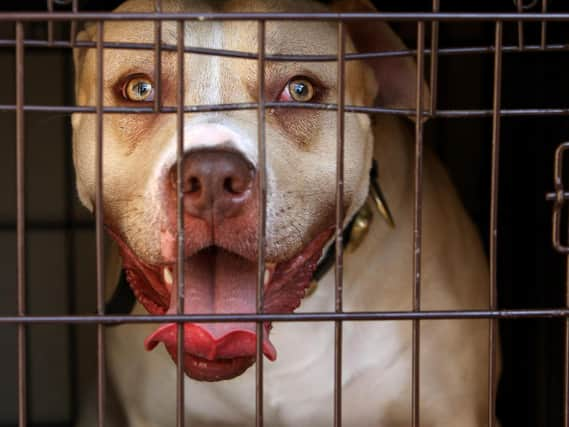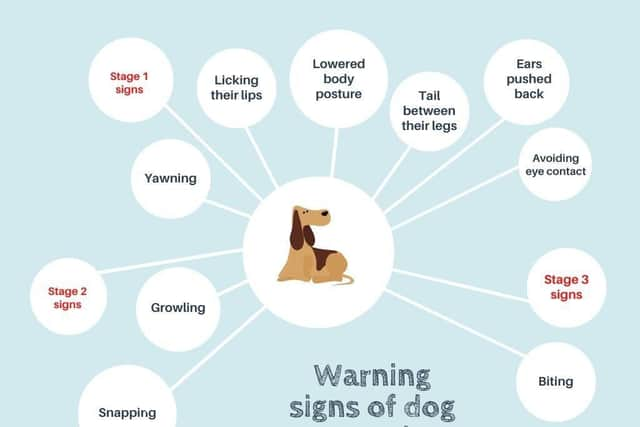How to spot the warning signs of dog aggression, reveals RSPCA animal welfare expert


Ownership licences, new control notices and more education about the signs of aggression could all help prevent attacks, claims a canine welfare expert.
This is because dogs can show aggression to protect their territory, or when frightened or in pain, according to Dr Samantha Gaines, lead author of our Breed Specific Legislation: A Dog’s Dinner report. The best way to deal with their aggression is to leave them alone, she adds.
Advertisement
Hide AdAdvertisement
Hide AdDr Gaines said: “People assume some breeds are more aggressive but it’s more down to how individual dogs are bred and their experiences, coupled with people’s behaviour towards them.


“Usually, dogs use aggression when they feel that they or something they value is being threatened. They try really hard to tell us how they are feeling and to avoid attacking. Most go through a repertoire of behavioural signals that they feel threatened before attacking but many people are not good at recognising them.”
The first signs of canine anxiety are subtle, she added. They include yawning, licking their lips, lowering their body posture, hanging their tail between their legs, pushing their ears back, or turning their head to avoid eye contact.
But as these signs are often missed, their behaviour can escalate to growling and snapping. And if that fails, they might bite, according to Dr Gaines.
Advertisement
Hide AdAdvertisement
Hide Ad“Some dogs learn that aggression is very effective so they quickly use it,” she said.
“But in general dogs do not bite and do not want to.
“If your dog is unhappy or has been displaying signs of aggression, I’d urge you to seek professional help with their behaviour. It’s really important to find someone who is properly qualified, as there are many people out there who are not up-to-date on research or do not protect dogs’ welfare.
“It’s very rare that bite cases are investigated, so we do not have the understanding of the factors leading to the aggression. What we do know are the high risk behaviours that provoke dogs.”
That is why the RSPCA is campaigning for “misleading” laws banning four breeds of dogs to be ended.
Advertisement
Hide AdAdvertisement
Hide AdThese breeds are Pit Bull terrier, Japanese Tosa, Dogo Argentino and Fila Braziliero.
Dr Gaines said: “The reason they were banned is because they were traditionally selected as fighting dogs. But even if you breed them in that way, there’s no guarantee of how they will behave. Current laws mislead people because they think only some breeds are aggressive.
"But any dog could bite.”
She also says that many of these breeds are being killed unfairly.
“It could also result in welfare issues. For example, if the RSPCA picks up a banned dog, it cannot be rehomed. We have to euthanise it. Many are lovely, friendly animals,” she added.
Advertisement
Hide AdAdvertisement
Hide Ad“The decision process for putting it down is based on how it looks. For example, if a dog looks like a Pit Bull, it will be put to sleep. But some breeds can look like them. So, we’re put in an emotionally difficult position of euthanising dogs based on how they look.”
That is why the RSPCA believes more laws are needed to help prevent attacks and stop dogs being killed.
“Current laws are reactive and punitive. There should be ways for a dog warden, for example, to have a conversation with and give guidance to people whose dogs are displaying aggression to stop the behaviour escalating. It’s down to a lack of understanding and knowledge about dogs,” Dr Gaines said.
The animal charity is calling for dog control notices to be introduced in England and Wales, as in Scotland. This would involve a canine welfare expert advising a pet owner about the reasons for their animal’s behaviour and practices to help control it.
Advertisement
Hide AdAdvertisement
Hide AdThe reintroduction of dog ownership licensing is also vital for cracking down on straying, fouling and antisocial behaviour, Dr Gaines added. She believes that paying an annual fee for owning a dog, as in Canada, could help to fund services that educate people about animal behaviour.
For advice about keeping children safe around dogs, visit https://www.rspca.org.uk/adviceandwelfare/pets/dogs/company/childrenTo find registered dog trainers and behaviour experts, visit http://www.abtcouncil.org.uk/